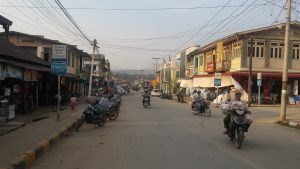Myanmar’s military has taken back control of a major district capital in Shan State, just over a year after losing it to the Ta’ang National Liberation Army (TNLA), an ethnic armed group.
In a report yesterday, the Global New Light of Myanmar stated that the Myanmar military on Wednesday “gained full control” over Kyaukme, a district center about 115 kilometers northeast of Mandalay, the country’s second-largest city, after a 21-day offensive.
“Tatmadaw reoccupied Kyaukme yesterday, and the local ethnic people welcomed Tatmadaw columns with Aung Thabyay and flowers warmly,” it stated, alongside photos of soldiers in key points of the town. The Irrawaddy, citing “sources on the ground,” reported that “regime military columns managed to penetrate Kyaukme from several directions, engaging in fierce clashes with TNLA troops before taking complete control of the town on Wednesday.”
The military’s recapture of Kyaukme, which was captured by the TNLA in August of last year, is the latest setback suffered by the loose coalition of ethnic armed groups and anti-regime militias that has been fighting the Myanmar military since the coup d’état of February 2021. The Global New Light stated that the military had “carried out rehabilitation activities” in the town, and that residents aged 18 and above would be able to exercise their right to participate in the military regime’s controversial election, the first phase of which is scheduled to be held on December 28.
In recent months, the Myanmar military has intensified its efforts to retake areas controlled by resistance groups ahead of the elections. It has carried out infantry offensives and fierce (and allegedly indiscriminate) airstrikes against resistance-held territories.
After excoriating the TNLA and its allies as “terrorists,” the Global New Light and other military mouthpieces claimed that the retreating TNLA troops burnt down the Kyaukme police station, as well as local administrative offices, schools, and religious buildings. However, The Irrawaddy cited witness accounts from locals, including videos shared by residents, which “indicated that the buildings caught fire after being bombed by drones.”
The TNLA, a member of the Three Brotherhood Alliance of ethnic armed groups, captured Kyaukme during the second phase of the Alliance’s Operation 1027 offensive. This also saw the TNLA and allied People’s Defense Forces seize significant territories in southern Shan State and northeastern Mandalay Region, including the gateway town of Nawnghkio, about 50 kilometers southwest of Kyaukme. This put it in a position to launch attacks on Pyin Oo Lwin, the hill-town that is home to the military’s Defense Services Academy, and even on Mandalay itself.
Further north, the Myanmar National Democratic Alliance Army (MNDAA), another member of the Alliance, all but expelled the junta forces from northern Shan State and, in August of last year, succeeded in capturing Lashio, the de facto capital of northern Shan State. The fall of Lashio was a significant defeat for the military regime, and was described at the time as “a watershed moment in Myanmar’s conflict.”
However, these gains have since gradually begun to erode as China, fearful of a possible collapse of the Myanmar military regime, has stepped up its pressure on the TNLA, MNDAA, and other ethnic armed groups to end their offensives and broker ceasefires with Naypyidaw. After the fall of Lashio, it shut border crossings between Yunnan province and MNDAA- and TNLA-held territories along the Chinese border and cut off the supplies of internet, fuel, and electricity upon which they rely. Beijing reportedly went so far as to detain MDNAA commander Peng Daxun after he traveled to Yunnan for talks with a senior Chinese envoy last October.
The MNDAA eventually agreed to withdraw from Lashio, which it handed back to the junta authorities, under the supervision of Chinese peacekeeping teams, in mid-April. While the TNLA has resisted Chinese pressure to hand back towns captured during Operation 1027, the Myanmar military has stepped up air strikes and infantry attacks on TNLA-held territories. In a blow to the TNLA, it succeeded in retaking the town of Nawnghkio, about 50 kilometers southwest of Kyaukme, in July.
A full reversal of the gains made during Operation 1027 remains implausible, particularly in Rakhine State, where the Arakan Army, the third member of the Three Brotherhood Alliance, has managed to establish its control over 14 of the state’s 17 townships. At the same time, the recent reversal of the TNLA’s gains in southern Shan State has allowed the military junta to consolidate its position and to some extent shifted the trajectory of the conflict in the region. Coupled with the upcoming election and the increased international support and engagement that is likely to get, this could well usher in a new phase of stalemate in the country’s civil war.





























